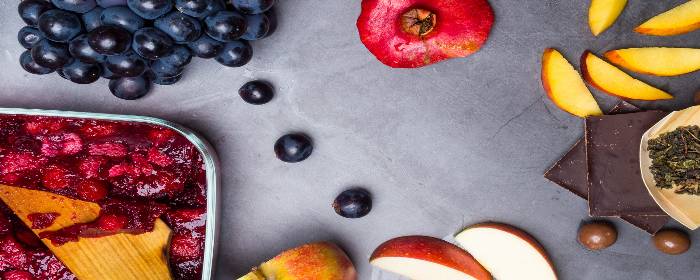
by admin | Oct 29, 2019 | COPD, Health Awareness
A decline in lung function can be both age-related and result from a disease, such as chronic obstructive pulmonary disease (COPD). Although there are medications available to help patients manage the symptoms of COPD, the disease has no cure. Thus, for both age-related and COPD-related decline in lung function, patients are limited in terms of their treatment options.
Recently, researchers discovered a potential therapy in flavonoids for improving lung function. This group of phytonutrients is found in nearly all vegetables and fruits and is known to have powerful antioxidants and anti-inflammatory properties. While there have been plenty of previous research showcasing flavonoids’ abilities in medical applications, studies on their effect on lung function have been limited.
In the most recent research, investigators focused on anthocyanins, a type of flavonoid which has been found in lung tissue shortly after being ingested. Based on findings, it appears that the plant chemicals may play an important role in minimizing mucus and inflammatory secretions. Study participants who consumed the most anthocyanins experienced improvements in a number of key lung function indicators over their peers, including a slower rate of decline in FEV1, which measures how much air a person can exhale in a second. They also experienced a slower rate of decline in FVC, the amount of air exhaled after taking a deep breath. Benefits were realized across people who had smoked as well as those who had not.
Good Sources of Anthocyanins
While the researchers note that quitting is the best choice smokers can make to improve their lung function, a diet rich in anthocyanins could be an effective way to boost lung function in former smokers and people who have never smoked. Anthocyanins are found naturally in red onions, berries, grapes, tomatoes, acai, kidney beans, and tart cherries.

by admin | Oct 21, 2019 | Health Awareness, Parkinson's Disease
Parkinson’s disease (PD) is a progressive nervous system condition which is diagnosed in more than 50,000 Americans each year. The disease affects movement and occurs when nerve cells in the brain don’t produce enough of the brain chemical dopamine.
Patients with Parkinson’s disease experience the death of neurons involved with the movement, which may lead to symptoms such as tremors, mobility challenges, slow movement, muscle rigidity, and speech changes. Cell death may be partially caused by a mutation for the protein α-synuclein (αS). While the mutated protein tends to cluster in neurons, ultimately causing their death, the normal protein resists clumping.
Researchers are now investigating whether estrogen could help to protect these movement neurons against clumping in people with PD.
Parkinson’s disease is most commonly seen in men and postmenopausal women, both of whom have low estrogen levels. While researchers still aren’t sure precisely how estrogen may act as a protective agent to safeguard movement neurons, studies have shown that brain-selective estrogen improved PD symptoms in mice. In the studies, the mice treated with estrogen therapy showed a higher rate of surviving neurons, as well as benefits in motor performance. It’s therefore suspected that estrogen treatment could be an effective therapy for delaying and reducing symptoms.
The exact causes of Parkinson’s disease are still being researched. While the condition can be genetic, most cases do not appear to run in families. As with many conditions, experts believe that environmental factors, including exposure to chemicals, could contribute to the disease. While there is still further research to be done both on the disease in general and the potential benefits of estrogen therapy, these most recent findings suggest that estrogen could hold promise as an emerging treatment for men and menopausal women with Parkinson’s disease.

by admin | Oct 15, 2019 | Health Awareness, Parkinson's Disease
For some time now, gut health has been suspected to play a key role in chronic conditions. We now know that there is significant interaction between the body’s immune system and bacteria in the intestinal tract, and researchers have become increasingly interested in how the immune system ties into conditions such as Parkinson’s disease (PD). But how do these factors all connect?
The Potential Role of Gut Infections in Parkinson’s Disease
Emerging research suggests Parkinson’s disease could have an autoimmune component. Autoimmune conditions occur when the body’s immune system confuses healthy cells for pathogens and sets out to destroy them. A small percentage of PD cases are caused by mutations in genes that code for the proteins PINK1 and Parkin, which help clear out damaged mitochondria. Individuals with these mutations are more likely to develop PD before the age of 50.
Yet, when scientists removed PINK1 and Parkin from mice in a recent study, thereby giving them the same mutations linked to Parkinson’s disease in humans, they did not develop the disease. The research team theorized that factors other than these genetic mutations alone would likely be required for PD to develop. In particular, they believed exposure to specific germs could trigger Parkinson’s disease in individuals with this mutation.
To test this theory, the mice were exposed to E. coli. As the researchers suspected, they experienced PD-like symptoms later in life, along with a loss of dopaminergic neurons in the brain. This suggests that in individuals with certain genetic mutations, gut infections can trigger an immune system response which targets healthy cells.
What the Findings Mean
This research has also led scientists to the conclusion that in people without functioning PINK1 and Parkin, intestinal infections can trigger PD, thereby demonstrating a clear gut-brain connection in the disease. While this doesn’t suggest that all PD cases are autoimmune, it does pose the theory that there could be an immune system element in some cases. Although the mystery surrounding Parkinson’s disease still remains, this discovery points to an interplay between the gut, genetics, and brain, which may ultimately pave the way for further developments in the realm of treatment.

by admin | Oct 7, 2019 | Health Awareness, Multiple Sclerosis
While researchers have been puzzled over the precise contributing factors behind Multiple Sclerosis (MS) for many years, it is widely believed that risk factors are both genetic and environmental. Recently, more evidence has been uncovered which points to the role of environmental factors, and specifically, diet, in a person’s likelihood of developing the condition. A new study on the influence of diet has been published in The Journal of Nutrition and indicates a link between red meat consumption and a reduced risk of first clinical diagnosis of central nervous system demyelination (FCD), a precursor to MS.
MS Risk & Red Meat Consumption: A Noteworthy Association
Researchers used data from more than 280 individuals who had experienced FCD, and more than 550 control participants who hadn’t. The participants were ranked according to a points-based diet score which measured how many servings of red meat they consumed as part of a Mediterranean diet. The scores of the people who consumed three or more servings of unprocessed red meat were found to have a reduced risk of FCD, compared to those who consumed two or fewer.
Why Could Red Meat Help?
According to one of the lead study researchers, the nutrients found in red meat, including omega-3 fatty acids, zinc, protein, potassium, vitamin D, and selenium, are all known to contribute to brain functioning. One critical component to the potential benefits is choosing high-quality meats, however. The research shows sources such as grass-fed beef are linked to the reduced risk, and the study participants largely maintained good eating patterns, as they followed a Mediterranean diet. This approach to eating is known to boost cardiovascular health and prioritizes the intake of healthy fats, vegetables, fruits, and whole grains, among other key components.
Who Do These Findings Affect?
The study findings show that for individuals who had a first-degree relative with MS, the risk would drop from 2 to 4% down to 1 to 2.5%. The greatest benefit is seen among individuals who have an identical twin with MS: for this population, the risk drops from 30 to 50% down to 14 to 32%. The findings also suggest that the more unprocessed red meat the individual consumes, the greater the reduction of risk may be.
Ultimately, the benefits of eating red meat appear to be greatest for the populations with a close relative with MS. It’s worth noting, however, that authorities such as the World Health Organization have issued warnings against red meat, and suggest that it could be carcinogenic to humans. Dietary modifications such as these should, therefore, be discussed with a doctor before being introduced into an individual’s daily routine.

by admin | Oct 4, 2019 | Health Awareness
We already know that eating candy all the time isn’t exactly a health-conscious choice. Most are processed and filled with added sugars, giving it a pretty low nutrition-to-calorie ratio. Yet, every diet should leave room to fulfill once-in-a-while cravings, and Halloween certainly qualifies as a special occasion. If you find yourself yearning for some sweets this October, don’t feel guilty about having a piece of candy. Instead, reach for one of the healthier varieties below, and try to pass on the rest.
The Healthiest Halloween Candy
While these snacks certainly wouldn’t be considered superfoods, they pack a more powerful nutritional punch compared to other options. Here are a few varieties to try:
Peanut M&Ms
M&Ms already have an advantage over other candies: since there are lots of them in a pack, you’re more likely to take your time enjoying them as your snack, thereby fulfilling your craving with just one fun-size portion. If the colorful candies are what you’re craving, go for the peanut variety: the nuts have protein and fiber, which can help keep you fuller longer. And, a fun-size pack clocks in at just 90 calories.
Reese’s Peanut Butter Cups
Reese’s lovers, rejoice: the famous cups make the list of more nutritional candies, thanks to the protein-rich peanut butter. Instead of reaching for the double-cup package, consider purchasing a bag of the single-cup varieties. One cup has 110 calories and 2.5 grams of protein, so it won’t derail your healthy eating habits. Plus, you can distribute the rest to any trick-or-treaters who stop by, as Reese’s are a favorite among kids, too!
Snickers
While you might think that the sugary caramel would land Snickers bars on the “bad” list, this candy is actually lower in sugar and higher in protein than most other types. Once again, we have peanuts to thank for the added nutrition. And, if you choose a fun-size bar, you can indulge in your chocolatey snack with just 80 calories and 9 grams of sugar.
The Least Healthy Halloween Candy
While no food has to be considered completely off-limits, be mindful when snacking on the candies below, as they fall at the very bottom of the list when it comes to nutrition.
Candy Corn
With a whopping 22 grams of sugar in just 15 pieces, candy corn defines “empty calories.” Most candy lovers won’t be too dismayed, however, as survey data shows this Halloween staple is actually one of the most hated varieties of the season. If you’re hungry for something sweet, you could have two Reese’s or Snickers for the amount of sugar in one serving of candy corn.
Airheads
Heavily processed, loaded with artificial flavors and coloring, and exceptionally sugary, there are many reasons why dentists loathe these sticky, nutritionally void candies. Not only do they leave you hungry for more since they have no protein or fiber, but they’re also likely to stick to your enamel, leaving you prone to tooth decay. If you just can’t shake the urge to have one, be sure to rinse and brush afterward.
Smarties
Another sugar-rich snack with empty calories, Smarties have carbohydrates and sugar but lack any meaningful nutrients like fiber or protein. Although one roll is only 25 calories, you’re better off getting your sugar fix with something that has a little more substance.
No matter which Halloween candy is your favorite, the best way to enjoy an indulgence this time of year is to do so without feeling bad about it. Halloween only comes once a year, so snack mindfully and remember to fill up on lean protein, plenty of veggies, and fresh fruit during other meals to balance out your diet. That way, you’ll make sure your body is getting all of the nutrition it needs, and there will be plenty of leeway for a piece of candy here or there.
Those with specific dietary needs, for example, those with Diabetes or considered Pre-Diabetes, should consult with their physician on any foods to ensure their health limits.

by admin | Sep 27, 2019 | Alzheimer’s Disease, Health Awareness
When it comes to chronic conditions like Alzheimer’s disease, experts are consistently exploring new research which could shed light on causative factors. The disease, as with many other serious illnesses, is believed to be caused by a combination of genetic, lifestyle, and environmental factors that impact the brain over time. Yet, researchers have recently discovered new findings involving gum bacteria and its potential role in Alzheimer’s, among other conditions. Neurodegenerative disease experts are debating one question: Could Alzheimer’s be linked to gum bacteria?
The Brain-Mouth Connection
According to an article published in Experimental Biology, bacteria involved in gum disease is suspected to have the ability to travel throughout the body. The bacterium, Porphyromonas gingivalis, is the key agent behind periodontitis and is believed to exude toxins connected to Alzheimer’s disease, rheumatoid arthritis, and aspiration pneumonia. Samples of these bacteria were found in the brains of individuals with Alzheimer’s, and researchers used animal studies to demonstrate how the bacterium can make its way from the mouth to the brain.
The bacteria were more common in the brain samples of Alzheimer’s patients compared to people without the disease of roughly the same age. Its key toxins, called gingipains, were present in these individuals. Based on animal studies, it appears that the migration of the bacteria from the mouth to the brain can be stopped with chemicals that interact with gingipains.
The Critical Importance of Oral Care
Dentists have long urged patients to take caution against periodontitis, the most serious form of gum disease. Left unaddressed, it can lead to tooth loss and can damage the soft tissue and bone that support the teeth. Yet, experts now believe that it can also have body-wide effects. Previous research has suggested that it the bacteria that causes the disease could travel through the bloodstream and cause other conditions, such as coronary artery disease or stroke. These newest findings suggest that proper dental care is especially important for individuals with genetic risk factors for Alzheimer’s disease or Rheumatoid Arthritis.
While gum disease is common, it’s often preventable. Although genetic factors may play a role in a person’s likelihood for developing periodontitis, there are many controllable factors which can also be addressed. Avoiding or quitting smoking, brushing and flossing regularly, and having dental cleanings at least once per year are some of the most effective strategies for avoiding gum disease and its potential complications.
Contact us at Stemedix to learn more about this and other promising studies!







 St. Petersburg, Florida
St. Petersburg, Florida
